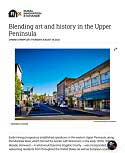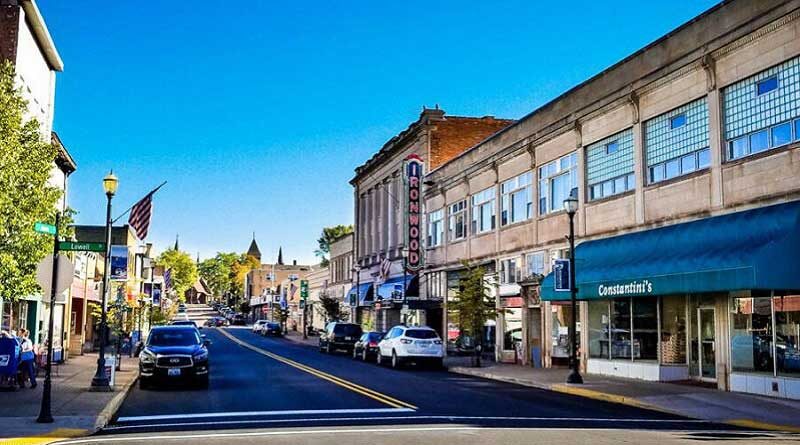Blending Art and History in the Upper Peninsula

By Dianna Stampfler
Early mining prospectors established operations in the western Upper Peninsula, along the Montreal River which formed the border with Wisconsin, in the early 1870s. Within a decade, Ironwood – in what would become Gogebic County – was incorporated, welcoming residents from throughout the United States as well as European countries like England, Finland, Germany, Italy, Poland and Sweden. It was this growing global community which created the colorful culture that is still celebrated and evolving today.
“Historically, Ironwood has always been a strong music and arts community, as the many immigrant groups who made up its early ‘boom’ years developed and fostered both their own traditions and worked together to create new performance organizations,” says Michael Meyer, director of the Ironwood Chamber of Commerce.
One of the first cultural sites was the Ironwood Public Library, founded in 1892 and housed within City Hall. A few years later, philanthropist Andrew Carnegie pledged $17,000 to the city for the construction of a new facility and in January 1902, the first Carnegie Library in the state of Michigan opened. Still standing proudly at 235 E. Aurora St., the building remains an anchor to the community and contains the original chairs, tables and circulation desk as an historical tribute to its 120-year history.
The 1920s were artistically important to Ironwood, starting with the construction of its two-story Neoclassical Memorial Building completed in 1923. This National Historic Site houses – among other things – a 1,500-seat auditorium, 47 stained glass windows (including a number depicting the World War I Battle of Argonne), a mural of local iron mines funded by the Works Progress Administration (WPA), a statue of a WWI doughboy and bronze tablets listing the names of area men who served during the Civil War, Spanish-American War and WWI.
The Ironwood Theatre hosted its “Grand Gala Opening” on June 30, 1928. Built as “an institution of entertainment” and an “everlasting symbol of confidence in the future of Ironwood” (according to newspaper ads of the time), this recently restored venue remains the jewel of downtown. As many as 60 events are held throughout the year at what is now known as the Historic Ironwood Theatre (HIT).
“Every June we feature our three local dance companies, in December and May our local Ironwood band and show choir perform, and we work with Downtown Ironwood Development Authority (DIDA) on First Friday events,” says Zona Wick, theatre president.
This September, the HIT will host a new Cinema Series (as there is no movie theater in Ironwood) as well as kicking off its Arts Midwest WorldFolk Festival which brings national and international acts to the community.
“We are so lucky to have our 1928 Barton Organ in its original installation and a young man here in Ironwood writes original scores for silent movies. He will be doing the Dr. Jekyyl movie in October,” Wick says.
Other stage entertainment, such as a comedian, Broadway play, local talent and tribute bands are in the works. The theater’s grant team has also been working on funding to bring a weeklong Finnish Kantele Music Festival in September 2023.
Among the newest cultural offerings in Ironwood is the Emberlight Festival, a branch of Theatre North – one of the oldest continually-operating theatres in the U.S., founded in 1964.
Like a growing number of inspirational ideas, Emberlight came to fruition during the height of the pandemic. In September 2019, Bessemer native Miles Mykkanen – the son of two high school band directors, a child performer (theater, piano and dance), former student at Interlochen Arts Academy, graduate of The Julliard School and winner of the 2019 Metropolitan Opera National Council Auditions – approached the board of Theatre North with a grand idea. He envisioned a series of cultural events that would highlight not only the finest in local talent but would bring national and international performers to town, while complementing existing offerings within the region.
“The Upper Peninsula has always celebrated a vibrant culture inspired by nations around the world — Sisu and Cudighis are part of our vernacular, and many people in our community wear their heritage with honor,” says Mykkanen, who himself is of Finnish descent (on his father’s side). “We also have a deep and important heritage with our Indigenous ancestors. The Emberlight Festival is neighbors to three Indigenous tribes: Lac Vieux Desert, Bad River and Lac du Flambeau. We are proud to find opportunities throughout our programming to highlight all of the heritage the Upper Peninsula has to offer.”
This year’s two-month Emberlight Festival, which runs through August 27, features over 30 unique world-class events at various locations around Ironwood. Coming up in August are Poetry in the Park, Heritage Flags, Mary Burns and the Ancestral Women Performers and the 67th Annual Range Art Association Show at the Memorial Building (hosted by an organization founded in 1954 to serve creative artists from northern Wisconsin and Michigan’s western U.P.).
Emberlight’s 2022 International Film Festival (August 20-26) is a highlight of the summer. This year’s event features nine screenings selected from over 770 submissions from six continents and 78 countries, with filmmakers from Nigeria, Italy and Mexico traveling to Ironwood for the festivities. Among the featured films are Laughing Matters, Memory Lane, Animation and Personal Documents.
Since its founding, Emberlight has grown into an independent non-profit organization, with downtown office space, a vibrant merchandise store and contracts with performers from around the world. And, according to Mykkanen, they’re just getting started as plans for 2023 (and beyond) are well underway.
While the Emberlight board focuses on developing original works and commissions, it is also building a roster of artists in the areas of classical music, opera, film, art, theatre, dance and writing to enhance the overall summer programming for local and visitors alike.
“Art (visual, musical, performance) is a growing economic force in this community as well as an attractive element in encouraging relocation here,” notes Meyer. “The higher quality of arts offerings, the more attractive they are for folks to make the journey to Ironwood to experience them.”
And journey they do. Mykkanen reports that last summer, the Emberlight Festival drew attendees from throughout the Michigan, Wisconsin and Minnesota, along with people traveling from as far as New York, Arizona, Montana, Texas and California to take in the various shows and performances.
“We are still exploring the best ways to attract and grow our audience but are hopeful that as Emberlight’s profile grows nationally we can help our local economy by attracting tourists and audiences,” Mykkanen says. “But the coolest thing that’s been happening is that when artists leave, they are immediately talking about making a trip back to the U.P. just to catch more waterfalls or Lake Superior sunsets. The Upper Peninsula is an artist’s ideal haven. We want to make the western Upper Peninsula a destination for audiences and artists alike.”
Emberlight has also re-energized the local arts community, encouraging collaboration and support among the various cultural organizations that have contributed to Ironwood’s historic fabric.
“Miles and the Emberlight board bring another level of cultural enrichment to the U.P.,” says Wick. “Our community is small and rural so bringing these national and international events enhances the lives of our residents.”
Mykkanen also recognizes the value of partnerships. While Ironwood may be small in terms of population and geographic footprint, the passion for the embracing, enhancing and expanding cultural offerings extends well beyond the city limits.
“The arts community in Ironwood is thriving and immense,” Mykkanen says. “The [community] organizations have held the torches of creativity in the western Upper Peninsula for decades, and Emberlight simply wouldn’t be possible without the generations of people who made sure art was kept alive in our community.”
OTHER ARTISTIC & CULTURAL SITES IN IRONWOOD
Miners Memorial Heritage Park – throughout July and August, “Art in the Park” is on display as well as Saturday afternoon Performance infusions (eight weekends of demonstrations and workshops lead by regional artists and part of the Emberlight Festival).
Ironwood Area Historical Society – housed along with the Ironwood Area Chamber of Commerce in the historic 1892 Richardson Romanesque style Chicago & Northwestern Railroad Depot building.
Gogebic Community College – founded as Ironwood Junior College in 1932 and offering a variety of classes in music, drama and art.
Downtown Art Place – the 11,500-square-foot City Centre building operates as an artistic hub – with studios, galleries and classrooms – as well as housing the concourse and main entrance of the Historic Ironwood Theatre.
Hiawatha – a 52-foot-tall, 16,000-pound fiberglass statue built in 1964 and touted as the “World’s Tallest and Largest Indian.”
Ironwood’s Art Park – established in 2015 (directly across from the Historic Ironwood Theatre, the Downtown Art Place and Art Studios on Aurora) to allow for the public display of outdoor artwork and musical performances.
The Miners Murals – two depictions within walking distance (the first at the corner of McLeod Avenue and Suffolk Street and the second on the side of the Lahti Building along Lowell Street near Aurora) both dedicated to the thousands of men who worked in the nearby Gogebic Range Mines.
Ironwood Self-Guided Historic Walking Tour – the city is working on this project now, in partnership with the Ironwood Area Historical Society. Ultimately, 20 signs with photographs and historical data will be installed on buildings throughout the city beginning and ending at Ironwood’s Historic Train Depot Museum. A brochure and map will also be available to help guide people to these locations.
Reprinted from Rural Innovation Exchange
Dianna Stampfler has been writing professionally since high school. She is the president of Promote Michigan and the author of Michigan’s Haunted Lighthouses and Death & Lighthouses on the Great Lakes, both from The History Press.

